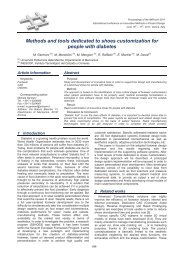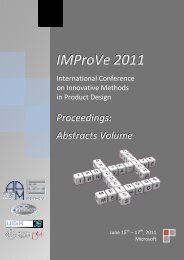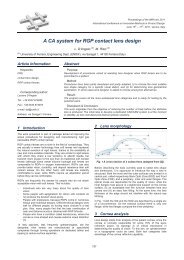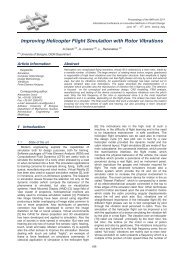IMProVe 2011 - Proceedings
IMProVe 2011 - Proceedings
IMProVe 2011 - Proceedings
You also want an ePaper? Increase the reach of your titles
YUMPU automatically turns print PDFs into web optimized ePapers that Google loves.
Teaching Product Design and Drawing History<br />
the reasons of the survey or the reasons bound with the design; certainly a renewal for<br />
the most usual ways of designing useful to produce different levels of knowledge and a<br />
new shared place for the exchange and discussion of the hypotheses, with what results?<br />
Keywords: Teaching experience, Representation techniques, Data management, Building<br />
engineering<br />
Corresponding Author: Giuseppa Novello Massai<br />
Tel.: 011 564 5306<br />
Fax.: 011 564 5399<br />
e-mail: pina.novello@polito.it<br />
Address: Politecnico di Torino – Dipartimento di Ingegneria dei Sistemi Edilizi e Territoriali, corso<br />
Duca degli Abruzzi, 24 - 10129 TORINO.<br />
Teaching Methods for Concept Design and Prototyping<br />
F. De Crescenzio (a), M. Fantini (a), F. Lucchi (a)<br />
(a) Second Faculty of Engineering, University of Bologna<br />
Abstract:<br />
In a product development process, the definition of an adequate design methodology<br />
allows to reduce the Time to Market (TTM) and to create new products meeting user’s<br />
requirements. The design of industrial products starts from the Mission Statement, which<br />
gives a brief description of the product and its goals, underling target market and<br />
stakeholders, assumptions and constrains that guide product development. Hence, in the<br />
early steps of the development process, alternative concepts of new products are<br />
generated, evaluated and then selected for further development and testing. In this<br />
phase, the first activities consist in identifying customer needs and establishing target<br />
specifications. Following actions regard concepts generation and selection. In this context,<br />
new technologies, such as knowledge based engineering and rapid prototyping have a<br />
significant impact on the reduction of the time and costs needed to verify the technical<br />
and functional aspects of the project. This paper reports the teaching experience carried<br />
out in the course of “Project Methodologies for Industrial Engineering” of the MSc in<br />
Mechanical Engineering at the Second Faculty of Engineering at the University of Bologna.<br />
The aim of this course is to supply students with design methodologies and all the related<br />
activities that are at the basis of concept development and prototyping. Therefore,<br />
students are directly involved, through a design experience, in the creation of a new<br />
product from some defined topics and issues. In addition to the conceptual design<br />
methods and the Computer Aided Industrial Design tools, students experience the Rapid<br />
Prototyping of the designed shape by means of a FDM (Fused Deposition Modelling)<br />
technique. In 2008, students, working in groups up to 4 persons, were requested to design<br />
a helmet, with an advanced level of customization. Following the phases of the design<br />
process, their ideas evolved into new products, which addressed latent needs defined in<br />
June 15 th – 17 th , <strong>2011</strong>, Venice, Italy<br />
135<br />
<strong>IMProVe</strong> <strong>2011</strong> - <strong>Proceedings</strong>










